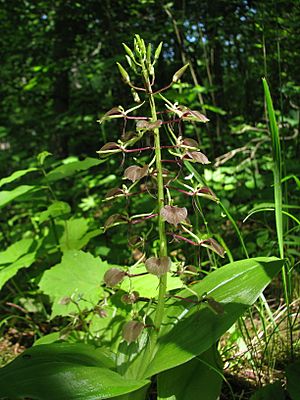Liparis liliifolia facts for kids
Quick facts for kids Liparis liliifolia |
|
|---|---|
 |
|
| Scientific classification | |
| Genus: |
Liparis (plant)
|
| Species: |
liliifolia
|
| Synonyms | |
|
List
Ophrys liliifolia L.
Cymbidium liliifolium (L.) Sw. Malaxis liliifolia (L.) Sw. Mesoptera liliifolia (L.) Raf. Achroanthes liliifolia (L.) Raf. Sturmia liliifolia (L.) Rchb.f. in W.G.Walpers Leptorkis liliifolia (L.) Kuntze Ophrys trifolia Walter Ophrys caroliniana Raeusch. Anistylis convallaria Raf. Liparis liliifolia f. viridiflora Wadmond |
|
The brown widelip orchid (Liparis liliifolia) is a special kind of orchid plant. It's also known by other names like the lily-leaved twayblade or large twayblade. This beautiful orchid grows naturally in parts of eastern Canada and the eastern United States. You can find it in different places like forests, bushy areas, and even on mountains. While it's generally doing well around the world, it's considered rare or even endangered in some northeastern states.
Contents
About the Brown Widelip Orchid
One of its common names, "lily-leaved twayblade," comes from its leaves. This orchid has two leaves that grow from its base. These leaves are light green, smooth, and shaped like an oval. They also have a faint line down the middle.
Its delicate flowers are usually mauve or purple. They grow in a loose group on a tall stem, which can be about 4 to 10 inches (10 to 25 cm) high. There can be up to 31 flowers on one stem! The petals and sepals (which look like petals) are long and thin, often hanging downwards. Sometimes, very rarely, the flowers can be green.
Each flower has a wide, flat, and almost see-through lip, called a labellum. This lip is pale purple with darker veins.
How the Orchid Grows
The fruit of this orchid is smaller than its flower stalks. The tiny seeds of the brown widelip orchid can only sprout and grow with help. They need a special type of fungus that lives in the soil. This fungus helps the seeds get the nutrients they need to start growing. This special fungus can be found wherever the orchid lives.
For many years, people debated how to spell liliifolia. But now, botanists (plant scientists) agree that the correct spelling has two "i"s in a row.
Where the Orchid Lives
The brown widelip orchid is native to eastern Canada, specifically in Quebec and Ontario. It also grows in the eastern United States. In the U.S., you can find it in places like the Appalachian Mountains, the Ozarks, the Great Lakes region, and along the Ohio and Upper Mississippi valleys. However, it does not grow in the southern coastal plains.
This orchid likes to live in forests, shrublands (areas with bushes), thickets, woodlands, and on mountains. It can be found as high as 4,200 feet (1,280 meters) up in the mountains. Even though the plant is generally secure worldwide, its numbers are dropping in many northeastern states. Because of this, it is considered rare or endangered in those areas. Still, you can often find it in many parts of its natural range.
Orchid Ecology and Threats
The brown widelip orchid is pollinated by flies. One type of fly that might help pollinate it is called Pegoplata juvenilis. Scientists think that other insects with long legs or mouthparts might also help pollinate these flowers.
However, there are some things that can harm this orchid. For example, floods caused by beavers can damage its habitat. Also, when swampy areas are drained, the orchid loses its home. Finally, insecticides (chemicals used to kill insects) can harm the flies that pollinate the orchid, which then makes it harder for the orchid to reproduce.

